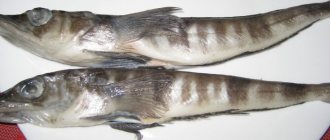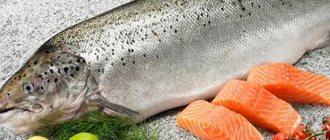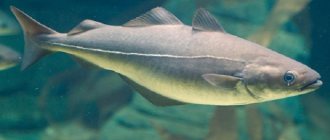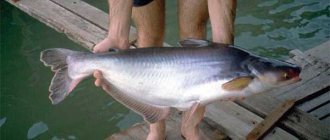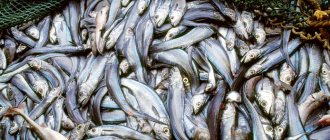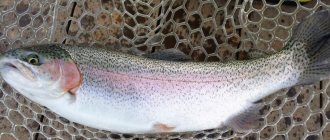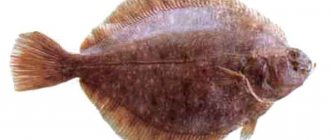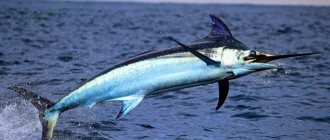Description of mullet
The body of the mullet is elongated, resembling a torpedo. The back is flattened, so the fish's nose is in line with the dorsal fin. The mullet is gray in color, with a silver tint on the belly. The back is darker than the sides, which are covered with longitudinal black stripes.
The scales are round and large. The mullet has two dorsal and pelvic fins, prebranchial and anal, with silver inclusions. The tail is dark gray, with clearly visible notches.
Due to the shape of the body, the Black Sea mullet fish is very mobile and maneuverable. Her head is small, with a sharp nose. The eyes are large, with fatty, wide eyelids. The mouth is small and toothless, with a pointed lower lip. Mullet can grow up to 90 centimeters. The smallest fish is 40 cm. The weight of a mullet can reach 7 kilograms. She lives from 12 to 15 years.
Description
Translated from Greek, mullet (kephale) means “head”, and is a common characteristic of 81 species of fish that live in the world's oceans, mainly in tropical and subtropical latitudes. The most common is the mullet, often called the mullet. He is an “indigenous inhabitant” of the Black Sea , in which, besides him, there are 3 more species of mullet fish: singil mullet , pointed mullet and pelengas mullet . Their interesting feature is the ability to jump high out of the water, especially in cases of danger or fright.
- Loban. The largest representative of the order, growing up to 80-90 centimeters in length and 6.5-7 kilograms in weight. By the age of 6-8 years, the period of sexual maturity, it can already reach 50-55 cm and 2-2.5 kg. The fish has an elongated torpedo-shaped body with a dozen longitudinal brownish stripes, covered with large scales: light-gray on the belly, blue-gray on the back. On a massive head with a wide forehead and flared nostrils there are two eyes, with fatty eyelids hanging over them, and a small narrow mouth with a thin lower lip. There are two dorsal and pelvic fins, they are separated, and the first upper one has 4 hard and sharp rays. The caudal fin is wide and powerful, V-shaped.
Singil mullet . A smaller fish, growing up to a maximum of 35-50 centimeters and 1 kilogram (specimens over “a kilo” are very rare in the Black Sea). It has a rounded head with a wide muzzle, narrow mouth and eyes with thin, fatty eyelids. The scales are large, gray and blue on the back, and silvery on the sides, on which several longitudinal stripes of golden color are visible. A characteristic feature is a “golden” spot on the gill cover.
Read also: Grater for potato pancakes photo
Mullet-singile Sharp-nosed. Outwardly it resembles a mullet, distinguished by its pointed snout. The maximum dimensions are also approximately the same - 40-50 cm and up to 1 kg in weight. The scales are large, their tone can vary from dark gray to dark brown on the back, and light silver on the belly. The edges of the second upper and caudal fins are painted black (the latter is V-shaped).
Sharp-nosed mullet (chularka) Pelengas. The second largest mullet species in Black Sea waters, it grows up to 70-80 centimeters and 5 kilograms. He is a “guest”, deliberately brought from the Sea of Japan and has taken root well in the Black Sea. By the way, in the “homeland” some of its specimens reach 1.5 meters in length and 12 kg of weight. It is distinguished by dark spots on the edges of large silver-light scales and an orange color of the iris.
Mullet-pelengas
Types of mullet
The Black Sea mullet is one of the most famous Black Sea fish. The indigenous subspecies are the singil, sharpnose and the famous mullet.
Pelengas is an “emigrant” brought to the Black Sea from the Sea of Japan. This had to be done due to a sharp decline in the population, since a lot of this fish was caught. Pelengas is distinguished by its unpretentiousness; it quickly found its habitat in the waters of the Black Sea. Initially, local residents were unhappy and treated the new “tenant” very hostilely, worrying that because of him the population of indigenous mullet would decrease or disappear altogether. But their worries were in vain. Thanks to the timely release of mullet into the Black Sea, the population of indigenous inhabitants of sea waters is now recovering.
Loban is the most common of the subspecies. It is significantly larger than other mullet species and is fast growing. At the age of five years it usually reaches 50 centimeters in length and weighs 2.5 kilograms. But there are also very large individuals. They grow up to 90 centimeters and weigh almost seven kilograms. They are excellent swimmers and can develop great speed as soon as they sense danger. Fish spawn from May to August.
Singil is the most numerous subspecies of mullet. But in size it is much inferior to the mullet. Basically, the singil weighs no more than a kilogram and reaches 35 centimeters in length. In terms of nutrition and behavior, the mullet does not differ from other subspecies, but its migrations to estuaries are longer. This is the main Black Sea commercial fish.
Sharpnose is the smallest subspecies of mullet. Its maximum weight reaches only half a kilogram, and its length is 25 centimeters. Otherwise, in terms of behavior and nutrition, it is no different from other subspecies.
Guess the riddle:
How old is a drunk hedgehog? Show answer>>
How many months in a year have 28 days? Show answer>>
How many minutes should you boil a hard-boiled egg? Show answer>>
The last letter of the letter is "n"
Answer to the question "Large mullet", 5 letters: mullet
Alternative questions in crossword puzzles for the word mullet
(colloquially reduced) person, animal with a large convex forehead
The “big-headed” relative of the mullet
The largest mullet
Commercial fish of the mullet family
(colloquial) person, animal with a large convex forehead
Mullet fish
Definition of the word loban in dictionaries
Wikipedia Meaning of the word in the Wikipedia dictionary The mullet, or mullet-mullet, or black mullet, is a commercial fish, the largest of the gray mullets.
Examples of the use of the word loban in literature.
For two days he watched as Lobanov, putting laboratory work aside, sat down in the accounting department in the morning, comprehending the secrets of expense items and appropriations.
Galimov and I had the rank of lieutenant colonel, Sasha Lobanov was just a junior justice adviser, that is, approximately a major.
Ivan, Semyon, Dimitry and Andrei Loban Ivanovich - Semyon is known for his unsuccessful campaign near Vyatka, Dimitri is known for his successful one, Andrei Loban was killed in a battle with the Tatars near Belev, their cousin Prince Fyodor Davydovich Paletsky-Pestry is known for his victory over the Tatars in 1428.
Through the clumsy harshness of Lobanov’s words, through his cockiness and inability to get along with people, Dmitry Alekseevich saw something else - Lobanov boldly raised the fundamental problems of automation, and even if Dolgin was right, Lobanov cannot be denied talent and passionate faith in his locator.
Read also: Technological map of borscht with meat
Lobanov is the hat: he organized such a successful partnership between Krasnopevtsev and Faleev and remains silent.
Source: Maxim Moshkov library
The mullet can confidently be called one of the symbols of summer holidays on the Black Sea. Tasty, healthy and nutritious, it is a traditional representative of the fish counters of southern markets and shops. Fishermen enthusiastically compete in the quantity of their catch and the size of the caught fish, housewives willingly include fish in the kitchen menu, and vacationers enjoy feasting on the white and tender meat.
Habitats
The mullet's habitat is wide. This is a sea fish. Black Sea mullet lives mainly in the Atlantic, Pacific and Indian Oceans, as well as in the Sea of Japan and the Black Sea. Prefers sub- and tropical latitudes. In Russia, the most common species are mullet, singil and pelengas.
Mullet lives in estuaries, seas and river mouths. Sometimes it goes into fresh water bodies (during spawning). But he spends the winter in the seas. Mullet does not migrate long distances, prefers familiar places, and moves only in large flocks.
Habitat and spawning habitats of mullet
Mullet is active in the warm season, going to the depths for the winter in large schools and sensitively reacting to the slightest warming of the sea. Moreover, sometimes mullet and pelengas flock together into single herds. It begins to “grow fat” in the spring, migrating to the coast and often appearing in shallow water. Tolerating both slightly and highly salty water, mullet often enters river mouths and estuaries and loves bays and bays. The fish is driven to constant movement by feeding on detritus (organic remains in the water column or on the bottom), in addition to which it can also feed on small crustaceans, invertebrates and even small mollusks.
Spawning occurs differently in different types of mullet. For example, sharpnose and singil lay eggs in August-September, going to the open sea for this. Pelengas also spawn in late summer - early autumn, preferring shallow bays, and female mullet spawn from late May to September, both in the open sea and off the coast. Mullet eggs are of the pelagic type, develop in the water column and are found far from the shore, but the fry very quickly acquire the habits of adults, rushing to shallow water.
Read also: TV program for today Ishim
Behavior and nutrition
Black Sea mullet is a schooling fish that prefers warm water, but not higher than 35 degrees. She is not afraid of the salt contained in the water and the amount of oxygen in it. The most unpretentious type of mullet is the pelengas. It feeds mainly on bottom silt, which contains many nutrients. To diversify its diet, this fish feeds on zooplankton, worms and small invertebrates.
Spawning
Females mature in the eighth or ninth year of life. During this period they reach 40 centimeters in length. Males mature a couple of years earlier than females. The Black Sea mullet goes to estuaries, bays and lower river reaches to feed. There, the fish first feed abundantly, then return to spawn (June - September) back to the sea.
Females deposit pelagic eggs in warm sandy shallow waters. The fertility of this fish is low. One brood can contain a maximum of only seven thousand eggs. After spawning, the fish leave again to feed, although most of them remain to winter in the sea.
Black Sea mullet: fishing and its features
For industrial scale it is caught everywhere. In summer, fish bite well in estuaries and river mouths. Fishing is carried out at a depth of three to five meters. Anglers consider catching mullet an art. There are ten different fishing methods, some of which are prohibited by law. The most popular and best fishing options are donk or float.
Despite the fact that the Black Sea mullet has several subspecies, they all look for food in the bottom layers, lead a single lifestyle and swim in schools. This fish is caught mainly with worms, nereis and sandworms. They can be found on the coast at low tide or simply bought in fishing shops. The mullet bite is best from the beginning of August. At this time, the fish swims straight to the shore to have a good meal before wintering.
You need to look for mullet on the coast, joining a crowd of fishermen concentrated in one place. In a more deserted place, the bite may not be as successful. For fishing, you need to choose a coast with a rocky or pebble bottom. This is where the silt lingers, which is what this fish feeds on.
Fishing will be more successful if you feed the mullet several days before fishing. Fresh white bread (a couple of loaves) is great for this. It needs to be broken and placed in water for half a minute. Then it is simply ground to a thick sticky mass. Add 150 grams of processed cheese and some small pebbles (no more than a third of the total bait). Then the baits are molded. In a few days, the mullet will get used to the fact that there is always food here, and by the time of fishing, the entire flock will be swimming in this very place.
Meaning
Mullet is the most valuable commercial fish.
The mullet is a valuable commercial fish. In winter and during feeding, it accumulates in large flocks, often together with another type of mullet - mullet (Mugil sojui). This fish is caught using fixed and cast nets, vents, nets and other fishing gear.
In winter, black mullet gather in schools.
In addition, this fish is of interest as an object of amateur and sport fishing. There are good prospects for commercial cultivation of this fish in the lagoons of Southern Primorye. Winters in the open sea.
If you find an error, please select a piece of text and press Ctrl+Enter.
